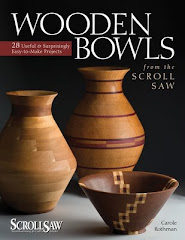I enjoy sharing my experiences with tools with other woodworkers, especially since there are so few places see or test out tools before buying. This video focuses on those aspects of the Hegner that make it a fine tool to own, and a rewarding one to use.
Thursday, August 29, 2013
Monday, August 19, 2013
Measure twice, cut once--with a twist!
You're probably familiar with the old adage cautioning you to re-check your measurements before you make your cuts. One problem, however, is that if you made a mistake once, you're likely to make the same error when you repeat your measurements.
To help minimize the waste of time, energy, and wood, here are two suggestions:
First, use a different method to measure the second time. For example, if you used a ruler the first time, use a tape the second time. If you measured top down the first time, measure bottom up the second time.
Second, take advantage of another person's input. Even if that person is not a woodworker, he or she can still help you measure.
Joe and I just replaced a rotten piece of fascia that had three angled cuts to make. Joe made an error on length, and I made an error on one of the angles. Between us, however, we managed to complete the job with only one minor re-cut, and no lost wood. BTW, never be tempted to use pre-primed finger-jointed wood for the exterior, especially for horizontal applications--it's worth the extra cost of decent wood to avoid the risk of premature rot.
To help minimize the waste of time, energy, and wood, here are two suggestions:
First, use a different method to measure the second time. For example, if you used a ruler the first time, use a tape the second time. If you measured top down the first time, measure bottom up the second time.
Second, take advantage of another person's input. Even if that person is not a woodworker, he or she can still help you measure.
Joe and I just replaced a rotten piece of fascia that had three angled cuts to make. Joe made an error on length, and I made an error on one of the angles. Between us, however, we managed to complete the job with only one minor re-cut, and no lost wood. BTW, never be tempted to use pre-primed finger-jointed wood for the exterior, especially for horizontal applications--it's worth the extra cost of decent wood to avoid the risk of premature rot.
Thursday, August 8, 2013
Scroll saw inserts
Some scroll saws, like the Hegner, have removable center inserts, while others, like the DeWalt, have an opening for the blade that is cut directly into the saw table. Having used both types of saws, I prefer removable inserts. Here's why:
1. If you accidentally cut into the table itself, there's not much you can do to correct the problem. If you cut into an insert, you can replace it easily.
2. If you need more support for your workpiece than a regular insert (left) provides, or if you are cutting tiny pieces that will fall through the opening, you can replace the regular insert with a zero clearance insert. The one for the Hegner comes uncut (center), and you cut into it with the blade of your choice (right).
If your saw has no insert and you must reduce the room around the blade, you can make do with a playing card taped to the table--less elegant, but better than nothing.
1. If you accidentally cut into the table itself, there's not much you can do to correct the problem. If you cut into an insert, you can replace it easily.
2. If you need more support for your workpiece than a regular insert (left) provides, or if you are cutting tiny pieces that will fall through the opening, you can replace the regular insert with a zero clearance insert. The one for the Hegner comes uncut (center), and you cut into it with the blade of your choice (right).
If your saw has no insert and you must reduce the room around the blade, you can make do with a playing card taped to the table--less elegant, but better than nothing.
Subscribe to:
Comments (Atom)





